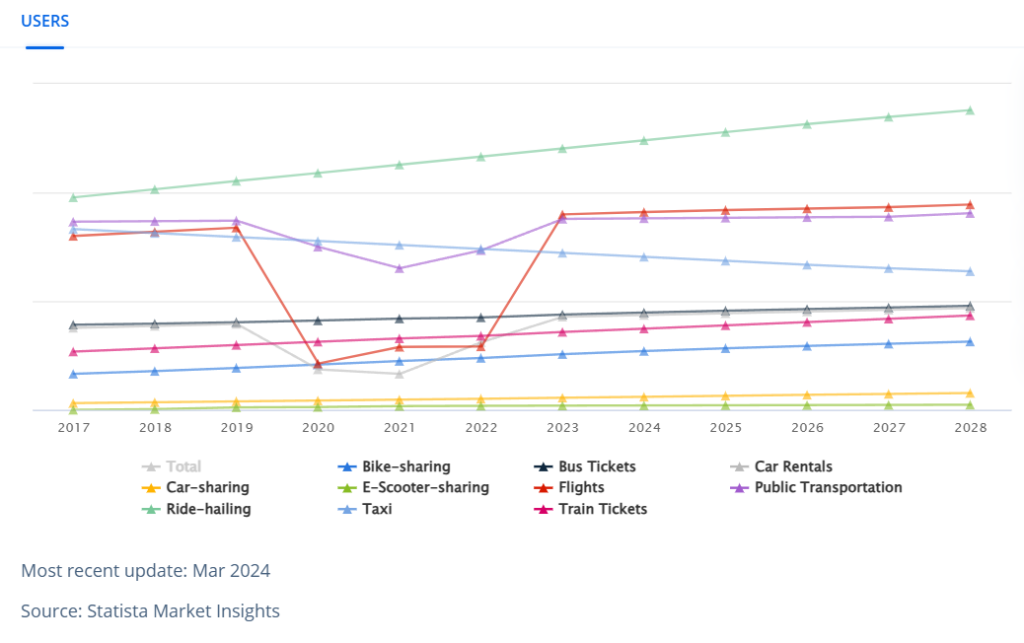The Saudi mobility market is experiencing substantial growth, driven by advancements in technology and a growing emphasis on sustainable transportation solutions. The shared mobility sector, encompassing services such as ride-hailing, car-sharing, and bike-sharing, is projected to generate significant revenue, reaching US$13.9 billion in 2024. This figure is expected to rise at an annual growth rate of 3.39%, culminating in a market volume of US$15.88 billion by 2028. The largest segment within this market is flights, anticipated to achieve a volume of US$9.176 billion in 2024. In this insight derived from the Saudi mobility consulting team at Eurogroup, we will explore the key drivers, trends, and opportunities in this dynamic market.

Market Dynamics and Growth Drivers
A critical factor contributing to the growth of the shared mobility market in Saudi Arabia is the increasing consumer demand for convenient, cost-effective, and environmentally friendly transportation options. The rise in smartphone usage has propelled the adoption of ride-hailing services, allowing consumers to book rides with ease. By 2028, the number of ride-hailing users is expected to increase to 13.79 million, with user penetration projected to rise slightly from 55.3% in 2024 to 55.6% by 2028. The average revenue per user (ARPU) is estimated to be US$671.00.

Online Sales and Global Comparison
Online sales play a significant role in the shared mobility market, with 82% of the total revenue expected to be generated through online channels by 2028. This trend highlights the growing importance of digital platforms in facilitating access to shared mobility services. In comparison, China is projected to lead the global market, generating a staggering US$412 billion in revenue in 2024. This global perspective underscores the rapid adoption and integration of shared mobility solutions within the Saudi market.

Consumer Preferences and Trends
Customers in Saudi Arabia are increasingly opting for shared mobility services due to the flexibility and ease of access they offer. Ride-hailing services have become particularly popular, thanks to the convenience of booking rides via smartphones. Additionally, car-sharing services are gaining traction, especially in urban areas where consumers prefer the flexibility of accessing a vehicle only when needed, rather than owning one. This shift in consumer behavior is driven by a desire for more efficient and sustainable transportation options.
Government Initiatives and Market Environment
Saudi Arabia’s Vision 2030 initiative, aimed at diversifying the economy and reducing reliance on oil, is a significant driver of innovation in the transportation sector. The government’s support for smart mobility solutions and sustainable transportation options is fostering a favorable environment for the growth of the shared mobility market. Initiatives such as the development of smart cities and improvements in public transportation infrastructure are key components of this strategy, creating opportunities for increased adoption of shared mobility services.
Macroeconomic Factors
The increasing rate of urbanization, coupled with a young, tech-savvy population, is fueling the demand for shared mobility services in Saudi Arabia. Government efforts to enhance public transportation infrastructure and reduce traffic congestion are further encouraging the shift towards shared modes of transportation. These macroeconomic factors, combined with changing consumer preferences and supportive government policies, are shaping the future of the shared mobility market in Saudi Arabia.
Conclusion
The Saudi mobility sector is becoming increasingly important as the market evolves. Effective Saudi mobility consulting can guide stakeholders through the complexities of this rapidly growing market, ensuring they leverage the latest technologies and strategies for optimal results. The evolving consumer preferences, robust government support, and continuous technological progress will collectively define the trajectory of shared mobility in Saudi Arabia.
In conclusion, the shared mobility market in Saudi Arabia is on a growth trajectory, driven by technological advancements, government initiatives, and increasing consumer demand for sustainable transportation options. By focusing on emerging opportunities and effective portfolio management, stakeholders can navigate the challenges and maximize returns in this dynamic market.



